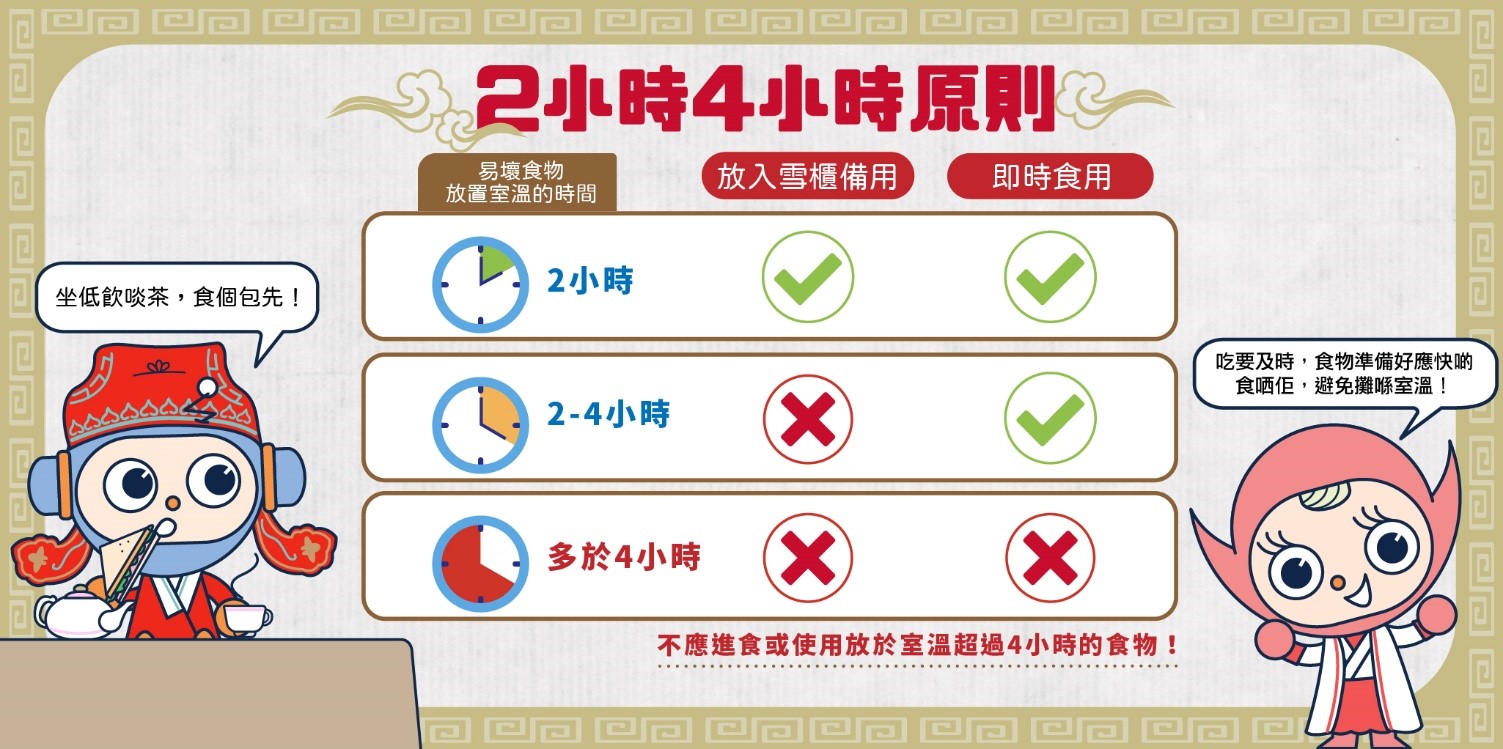
Feature Article
Food Safety and Flooding
Hong Kong experiences protracted rainstorms from time to time during summer and typhoon seasons, which may lead to flooding in some locations. Floodwater can contaminate food, and adverse weather may cause local or widespread power cuts, resulting in disruption of refrigeration and hence spoilage of perishable food. To provide for a rainy day, it is now a good time to review your contingency plan and follow-up action to ensure food safety.
Food Safety Hazards of Floodwater
Flooding causes potential food safety concern. Food items may be immersed in contaminated floodwater which may carry pathogenic microorganisms such as E. coli, Salmonella, hepatitis A virus and norovirus, as well as other contaminants. Besides, dampened food is susceptible to mould growth. Therefore, to ensure food safety, it is important to take proper precautions before and after a flood.
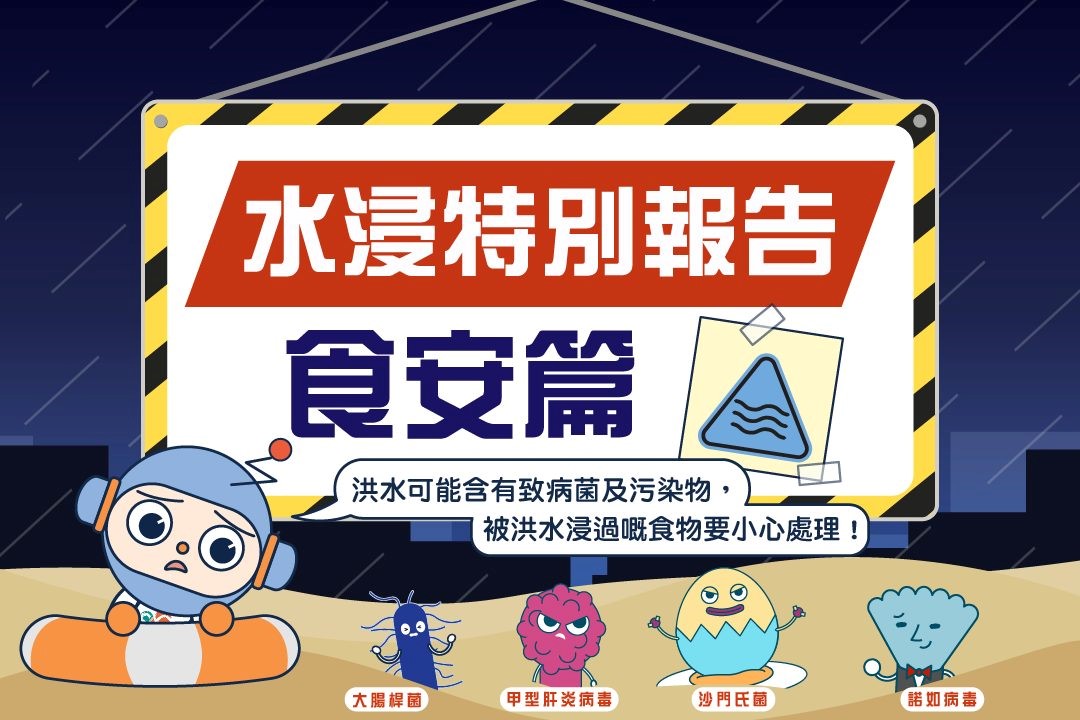
If flooding is expected, food storage areas and refrigerators should be kept away from floodwater as far as possible. After flooding, make sure to wash and disinfect all affected work surfaces, utensils and kitchen equipment before handling food. Dispose of wooden chopping boards and wooden utensils that have been immersed in floodwater.
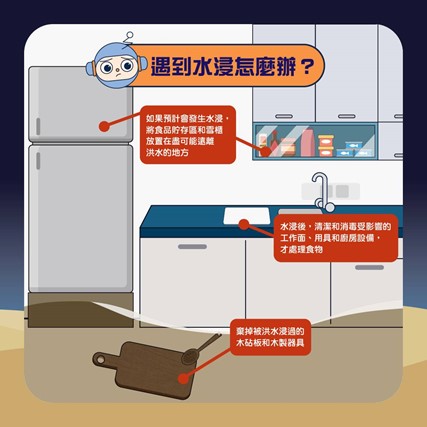
Food Salvage after Floods
When planning to salvage food after floods, it is most important not to eat any food that has been immersed in floodwater but is not packaged in a waterproof container. Only commercially manufactured metal cans with double-seamed lids and retort pouches (i.e. the packaging comprised of a flexible foil laminate for holding shelf-stable food (as shown in the diagram below)) are regarded as waterproof food packaging. Food items with packaging showing signs of swelling, leakage, rusting or dents should be discarded, while the intact ones can be salvaged for consumption as long as they are handled with care. First, remove the packaging labels and wipe or brush away the dirt or silt attached. Then, wash the packaging of the food items with water and soap and rinse thoroughly before immersing the food items in clean boiling water for 2 minutes for sanitisation. Allow the sanitised items to air dry for at least 1 hour, relabel them with product information such as the product name and expiry date before storing. These items should also be marked "to be used first" and consumed as soon as possible.
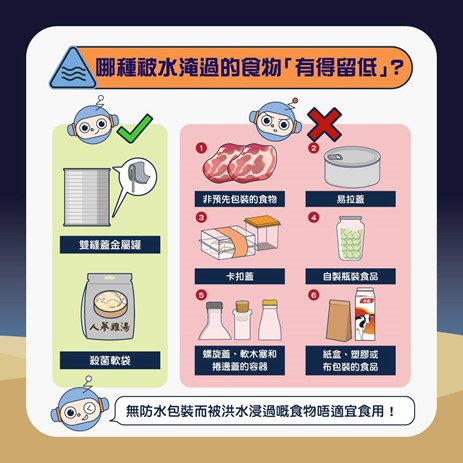
Types of food packaging that can and cannot be kept after immersion in floodwater
All non-prepackaged food items and those without waterproof packaging (e.g. containers with screw caps, snap lids, pull tops or crimped caps) that have been immersed in floodwater should be discarded. Food in paper carton, plastic or cloth packaging, as well as home-canned food that have been immersed in floodwater should also be tossed away. This is because there are no practicable methods of reconditioning or processing to salvage these food items.
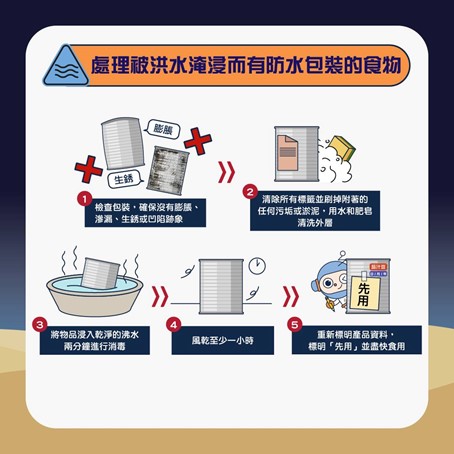
What to Do in Case of a Power Cut?
Rainstorms and flooding occasionally cause disruption of power supply, rendering refrigerators and freezers incapable of keeping food at suitable temperatures. Upon a power cut, take note of when it began. Keeping the refrigerator and freezer doors closed can help maintain a suitable storage temperature. When power supply is restored, handle perishable food items such as meat, seafood, eggs, dairy products and cooked dishes according to the "2-hour/4-hour rule". Do not taste the food to see if it is safe to eat if the power cut has lasted more than 4 hours. If in doubt, toss away the food.
Roles of Food Businesses
Food businesses have the responsibility to ensure food safety, and should not provide for human consumption food that has been spoiled, rotten or need to be discarded due to floods or power cuts. Defective food products should be set aside, put into garbage bags and tagged as unfit for human consumption. Condemned food items should be safely disposed of to ensure that they will not be consumed. Subsequent to an emergency, business should be suspended until thorough clean-up and disinfection are completed in order to prevent foodborne diseases caused by food contamination or poor environmental hygiene.
Mascot ON in Lesson
Proper Storage – Key to Minimising Nitrite Level Increase in Cooked Vegetables
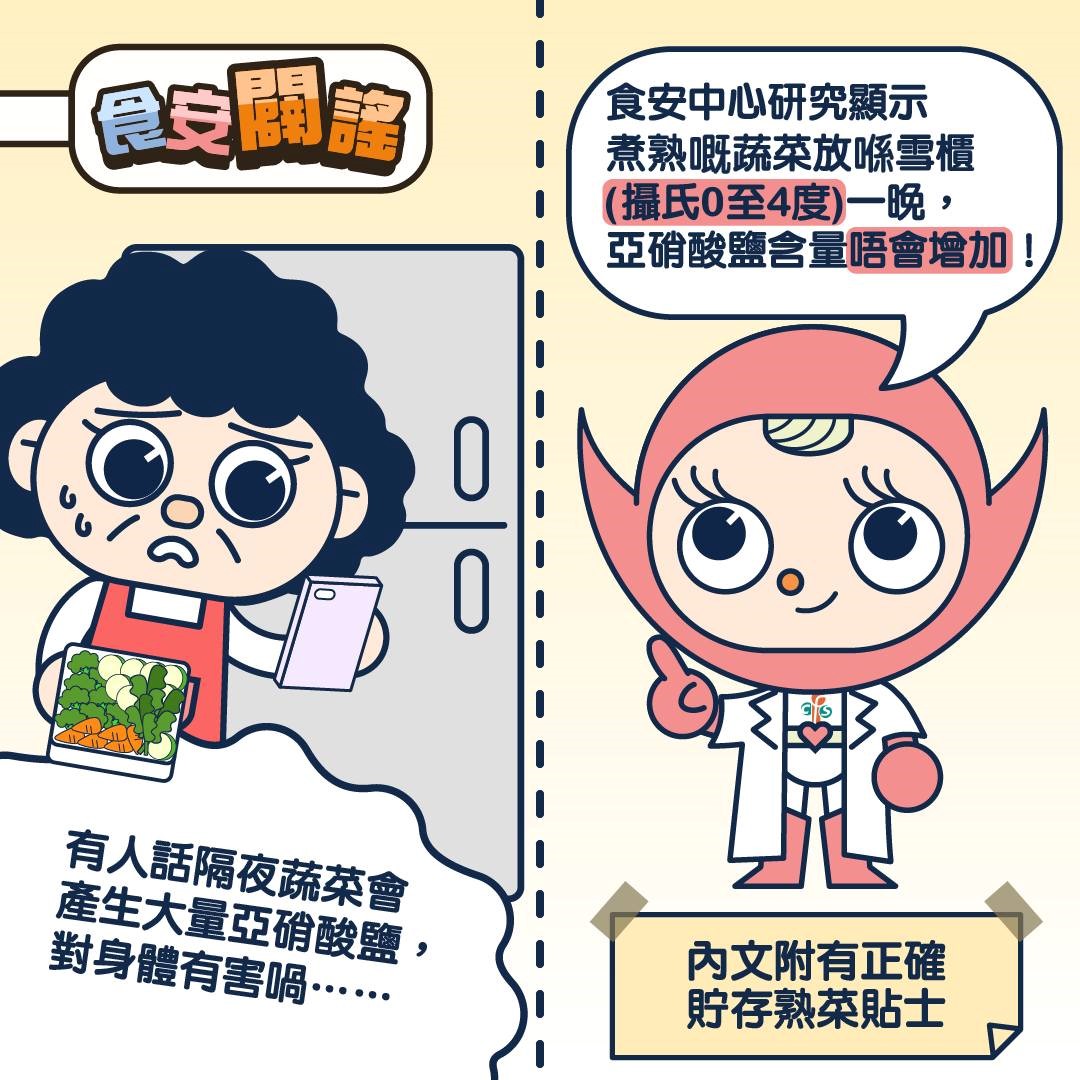
Vegetables are an important part of a healthy diet. However, some people prefer not to bring vegetables cooked on the previous day to the workplace for lunch out of concern that they might contain harmfully high levels of nitrite. In view of this, the Centre for Food Safety (CFS) conducted a risk assessment study on the nitrite levels in cooked vegetables.
None of the vegetable samples was found to contain nitrite before or shortly after cooking. When stored at refrigerated temperature (0 to 4℃) overnight, nitrite was likewise not detected in any cooked vegetable sample. However, when stored at room temperature, the nitrite levels started to increase in some samples after storing for 12 hours. The study results revealed that the storage temperature has a significant impact on the nitrite levels in cooked vegetables.

Members of the public are advised to store cooked vegetables properly to delay nitrite formation. Leftovers should be refrigerated within 2 hours after cooking and consumed as soon as possible. Home-packed meals or lunchboxes should be stored in a fridge immediately upon arrival at the workplace.

Food should be reheated thoroughly until its core temperature reaches 75℃ before consumption. A diverse diet including a variety of vegetables is essential for better health.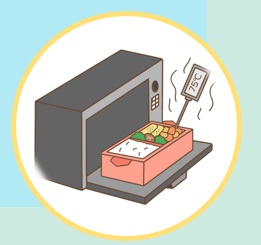
Dining Out
Careful Selection of Food When Dining out – Listeria Monocytogenes in Food
Listeria monocytogenes is a pathogenic bacterium. It is universally found in the environment, particularly in soil, vegetation, animal feed, and in human and animal faeces. Such bacterium can survive and multiply at temperatures as low as 0℃, however, it can be easily destroyed under normal cooking temperature. Consuming Listeria contaminated food may lead to the development of a disease called listeriosis.
Listeriosis is a foodborne disease caused by Listeria monocytogenes. Though cases of listeriosis are reported infrequently in Hong Kong, there have been a number of overseas cases in recent years. Healthy individuals rarely develop symptoms after exposure to Listeria contaminated food. However, the effect on susceptible populations like pregnant women, newborns, the elderly and immunocompromised people can be severe, and may result in septicaemia, meningitis, encephalitis, miscarriage, stillbirth or premature birth in severe cases.
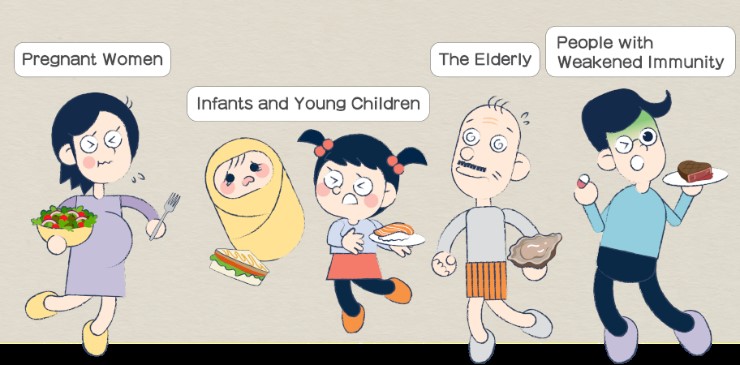
Susceptible populations
While eating contaminated food is the main route of listeria infection, listeriosis can also be contracted from contact with infected animals or humans and from mother to foetus or newborn.
Ready-to-eat foods may be contaminated during processing and the bacteria can multiply during food distribution and storage. Vegetables may be contaminated through soil or the use of manure as fertiliser. High risk foods include deli meat and ready-to-eat products (e.g. cooked, cured and / or fermented meats and sausages), soft cheese and cold smoked fishery products.
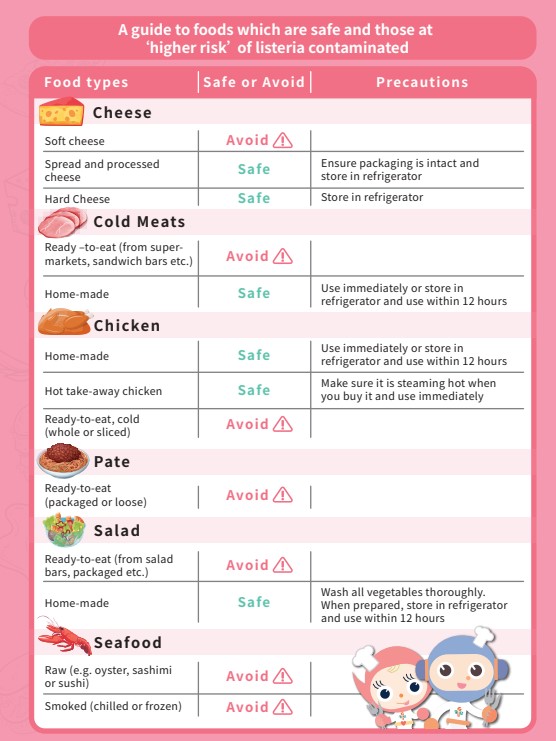
Susceptible populations should avoid foods like prepared salads, unpasteurised milk and their products, soft cheese, smoked or raw seafood, cold meats, pate, etc., as the bacteria are more frequently found in these foods. Listeria are rather unique in the sense that they can multiply in refrigerated foods that are contaminated. Proper food handling techniques and good personal hygiene practises should be adopted to minimise the chance of infection.
Listeriosis in Pregnant Women
During pregnancy, pregnant women have weakened immune systems and thus are more susceptible to listeriosis. While pregnant women, when infected, may just experience mild, flu like symptoms or even with no symptoms, Listeria. monocytogenes can pass to the baby through the placenta. During the first trimester of pregnancy, listeriosis may cause miscarriage. As the pregnancy progresses to third trimester, listeriosis can result in preterm birth, delivery of a low-birth-weight infant or even infant death. About half of the infants infected at or near term may die.
Foetuses who suffer a late infection may develop various health problems, including mental retardation, paralysis, blindness, impairments of the brain, heart and kidney after birth.
Advice to the Public
- Maintain good food and personal hygiene.
- When buying ready-to-eat foods (especially the refrigerated ones with long shelf-lives), check whether the food package is intact and the expiry date on the label is not overdue .
- Consume perishable foods that are precooked and ready-to-eat as soon as possible.
- Reheat leftovers thoroughly before consumption.
Advice to Susceptible Populations
- Avoid consuming refrigerated ready-to-eat foods with long shelf-lives (e.g. cold-smoked seafood including salmon, soft cheeses and deli meat) unless they are cooked thoroughly.
- Only eat foods that are served hot instead of lukewarm.
- Best to avoid any buffet-type meal. If not possible, choose hot dishes only and avoid pre-prepared salads (such as those in salad bars).
Healthy Eating Basics and Smart Food Choices
Healthy Eating Basics
Food Safety Advice for Takeaways and Food Delivery
Amid the ongoing COVID-19 epidemic, food delivery from food premises is becoming more popular. With the advance of mobile applications and technology, food orders can be easily made at our fingertips. However, many steps are involved in the food handling process from the kitchen to the customers' table. This raises concern about the food safety risks involved in the food delivery service, including the lack of proper temperature control and the risk of cross-contamination throughout the delivery process. It is necessary for food business operators, delivery staff and customers to join hands to ensure that the delivered food is safe for consumption.
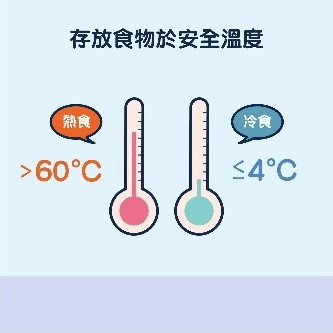
Food businesses should avoid preparing food too far in advance, while deliverers should minimise the time for delivery. During the delivery process, the temperature control requirements for keeping hot food hot (above 60℃) and cold food cold (at or below 4℃) should be fulfilled. If meals cannot be kept at these temperature ranges, the "2-hour/4-hour rule" should be followed (i.e. if prepared food has been kept at room temperature for less than 2 hours, it can be refrigerated for later use or consumed within the four-hour limit; if the food has been kept at room temperature for more than 4 hours, it should be discarded). Food business operators are also encouraged to adopt more measures proactively to prevent food from being tampered with in the delivery process to safeguard food hygiene.
- Members of the public should take heed of the following advice when ordering and consuming takeaways and delivered meals:
- Buy foods and order delivered meals from reliable online shops and food premises;
- Avoid high-risk foods such as sushi and other raw or undercooked foods, particularly for susceptible populations including the elderly, young children, immunocompromised people and pregnant women;
- Refrain from ordering meals that need to be delivered over a long distance, as they are prone to spoilage and contamination without strict control over time and temperature;
- Use heat-resistant containers if reheating of food is needed because some takeaway containers cannot withstand high temperatures; and
- Check the conditions of the delivered foods carefully upon receipt and consume them as soon as possible.
Smart Food Choices
Nourishing Winter Soup – Double-Boiled Whelk and Matsutake Soup with Fish Maw
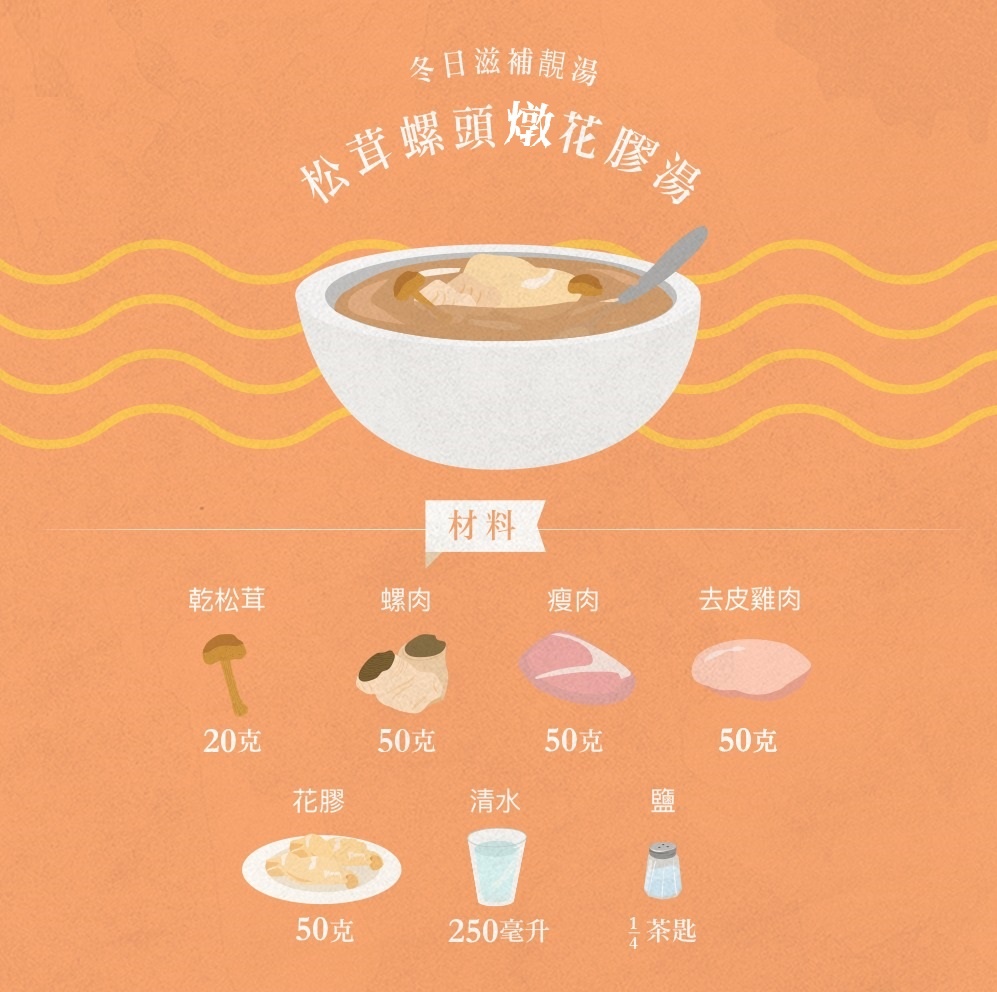
Nothing beats a bowl of warm soup when it comes to nourishing your body on a chilly day. However, as takeaway soups may contain MSG, this wholesome fish maw soup is worth a try for the sake of your health. The use of lean pork and skinless chicken help reduce the fat content, and fish maw and whelk meat are rich in protein while low in cholesterol, giving the soup a strong flavour without too much added salt. It is definitely a healthy soup choice for the winter!
Interested readers may visit the "EatSmart Restaurant Star+" website of the Department of Health (https://restaurant.eatsmart.gov.hk/eng/content.aspx?content_id=1028) to warm up the winter with this stew soup.

News on CFS
1. Hygiene Talks at District Health Centres
To tie in with World Food Safety Day 2022, the CFS has set hand hygiene as the theme of Food Safety Day 2022 and organised events in collaboration with District Health Centres (DHCs) to further enhance public understanding of the importance of hand hygiene in safeguarding food safety. Talks on hand hygiene were held at Kowloon City DHC Express, Kwun Tong DHC Express, Yau Tsim Mong DHC Express and Central and Western DHC Express in August and September with a view to raising public awareness of hand hygiene and food safety.
Moreover, the CFS has distributed food safety leaflets and pamphlets to all DHCs throughout Hong Kong to enhance the public's awareness and knowledge of food safety and hygiene.


2. Food Safety Talks for the Public
On 15 September, the CFS held the last food safety talk of the year for the public at Sha Tin Town Hall. Topics such as how and when to wash hands and proper food handling practices were covered, with a view to enhancing understanding of food safety and healthy eating among the public.

To participate in the food safety talks in the coming year, please refer to the details on the CFS website.
3. Briefings for Undergraduate Students
On 10 and 11 October, the CFS held briefings for students of Bachelor of Science (BSc) programmes in Community Health Practice and Public Health Programmes, Faculty of Medicine, Chinese University of Hong Kong (CUHK) and BSc programme in Chemistry, University of Hong Kong (HKU) respectively. During the briefings, the role of the Food and Environmental Hygiene Department in food safety surveillance and control in Hong Kong was introduced for students to have a preliminary understanding of the work of the CFS and to assist them in planning their career for professional development.
Briefing for Students of BSc Programmes in Community Health Practice and Public Health, Faculty of Medicine, CUHK
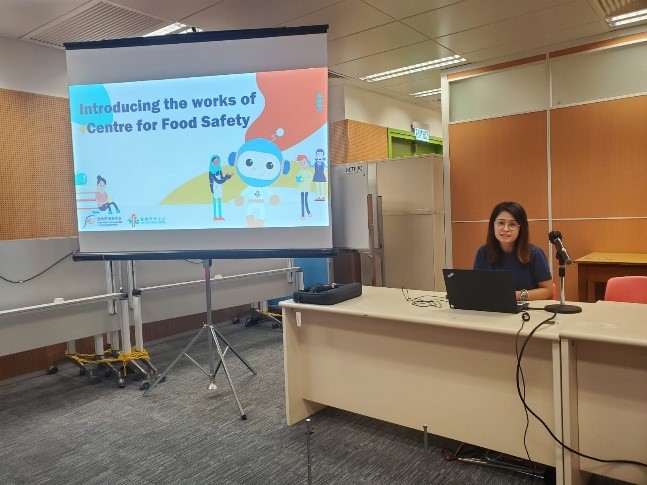

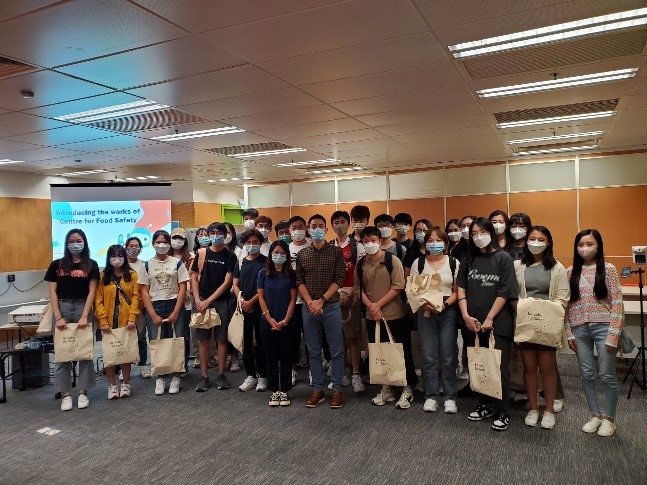
Briefing for Students of BSc Programme in Chemistry, HKU
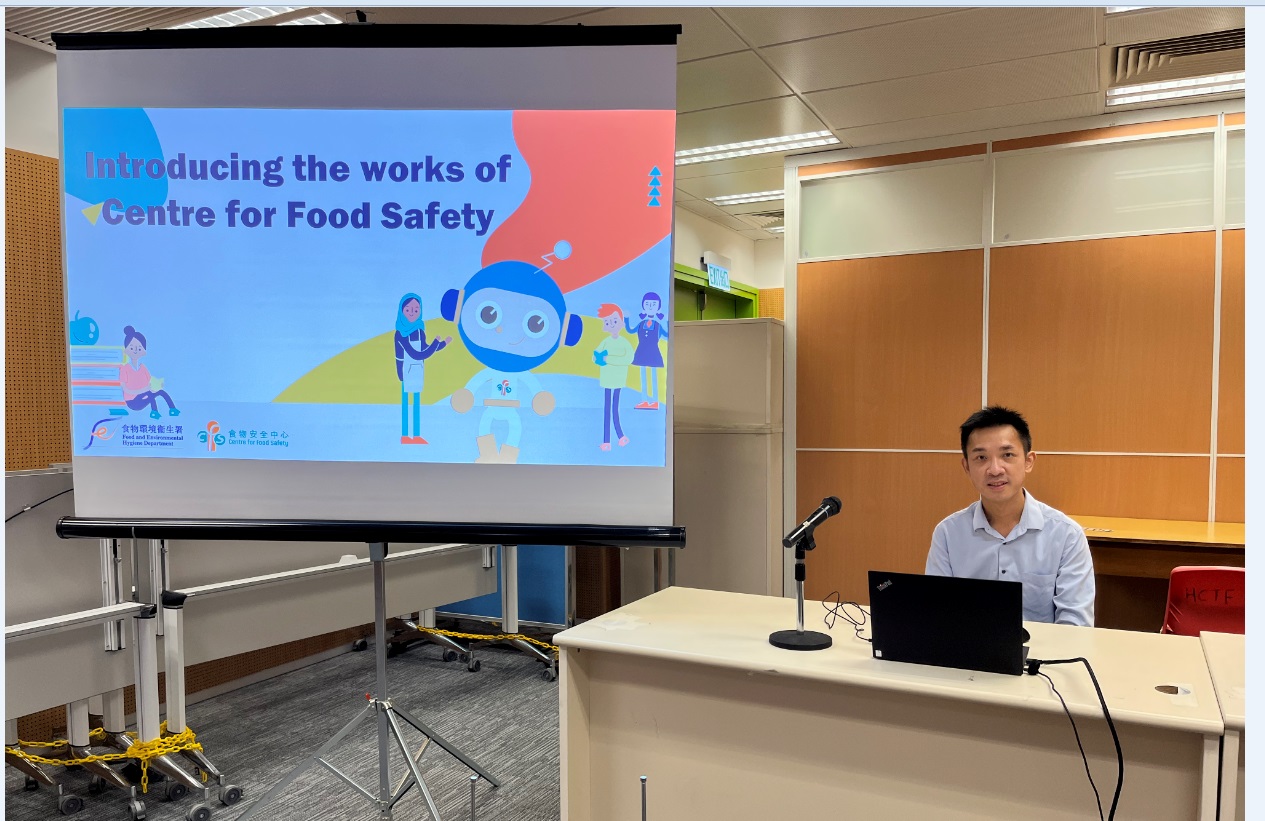


Ask Our Mascots
Dispelling Food Safety Myths – Seeking Redress for "Freezer-burnt" Meat
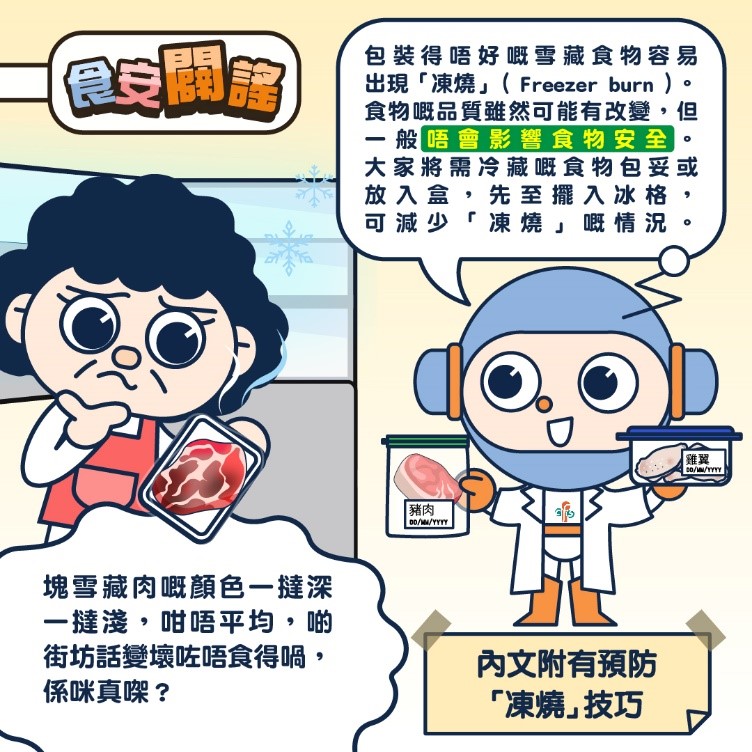
#Auntie TONG: How come this piece of frozen meat is covered in dark-coloured patches and ice crystals? I've heard some people in the neighbourhood saying that such meat has been spoiled and should not be eaten. They also say that the whole piece of meat has to be thrown away. Is this true?
#Mascot ON: Well, it's not necessary. This piece of meat has shown signs of "freezer burn" only. If frozen food stored in the freezer is not wrapped properly, some parts of it may become tough, shriveled, discoloured, or covered in ice crystals, which, normally, will only affect food quality but not safety. That said, consumers may remove the "freezer burnt" parts before or after cooking as desired.
#Mascot MUI: Here are some tips on preventing "freezer burn" on food:
- Mare sure food is wrapped properly before freezing by putting it in a zipper bag or an airtight container
- If a zipper bag is used, squeeze out excess air before sealing
- Label the package with the food name and expiry date before freezing
- Consume the frozen food within the storage time recommended by the manufacturer
As for hot food, always remember to allow it to cool before freezing. Fancy knowing more about the proper ways of handling frozen food? Browse the following webpage at once!
https://www.cfs.gov.hk/english/multimedia/multimedia_pub/multimedia_pub_fsf_190_02.html
Food Safety Quiz
- Which of the following practice cannot prevent bacteria like Bacillus cereus and Staphylococcus aureus from producing heat-stable toxins?
- Cover hand wounds with waterproof adhesive dressings
- Always keep food preparation areas clean
- Allow prepared food not for immediate consumption to cool at room temperature
- When will the Harmful Substances in Food (Amendment) Regulation 2021 and the Food and Drugs (Composition and Labelling) (Amendment) Regulation 2021 come into operation?
- 11 December 2022
- 1 February 2023
- 1 December 2023
- Which of the following about pasteurised foods is correct?
- They should be refrigerated at or below 4°C
- They should be eaten as soon as possible once opened
- Their expiry dates should be checked before consumption
- All of the above
Answers:
1. C 2. C 3. D
Diary of Mascot ON
Be a "Time Management Master" in the Food Industry
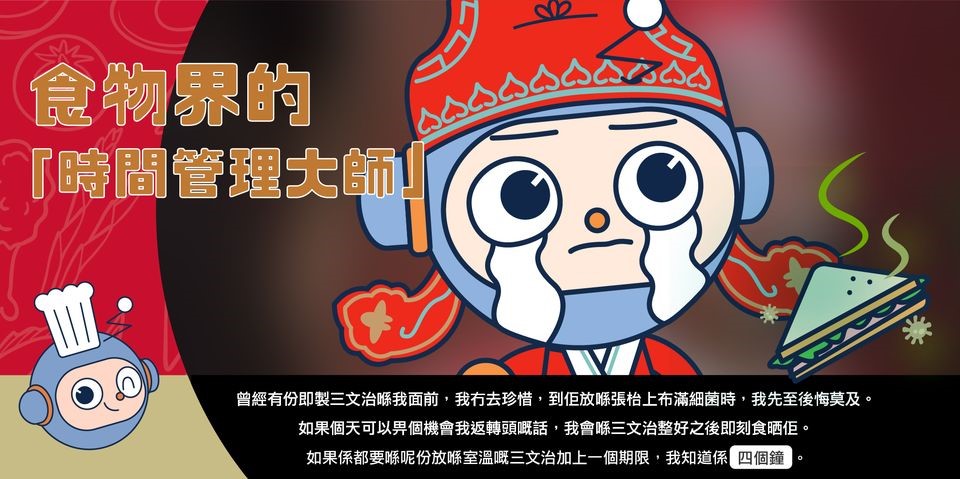
#Mascot ON: There was once a made-to-order sandwich placed in front of me but I did not cherish it. It's too late for regrets when it, lying on a table, was heavily contaminated with bacteria. If I were given a second chance, I would have finished the sandwich as soon as possible after it was made. And if I were to assign an expiry date to this sandwich, which was stored at room temperature, I know it should have been 4 hours.
#Mascot MUI: I've taken pains to make the sandwich for you. You were so absorbed in video games that you didn't eat it! It has been very hot recently, perishable foods storing at room temperature are prone to bacteria growth!
The consumption of food immediately after preparation is certainly the safest, otherwise follow the "2-hour/4-hour rule".
According to the "2-hour/4-hour rule", if prepared food:
- has been placed at room temperature for less than 2 hours, it should be finished immediately or stored in the fridge
- has been placed at room temperature for a duration of 2 to 4 hours, it can be eaten but should not be returned to the refrigerator
- has been placed at room temperature for more than 4 hours, it should not be eaten or used
